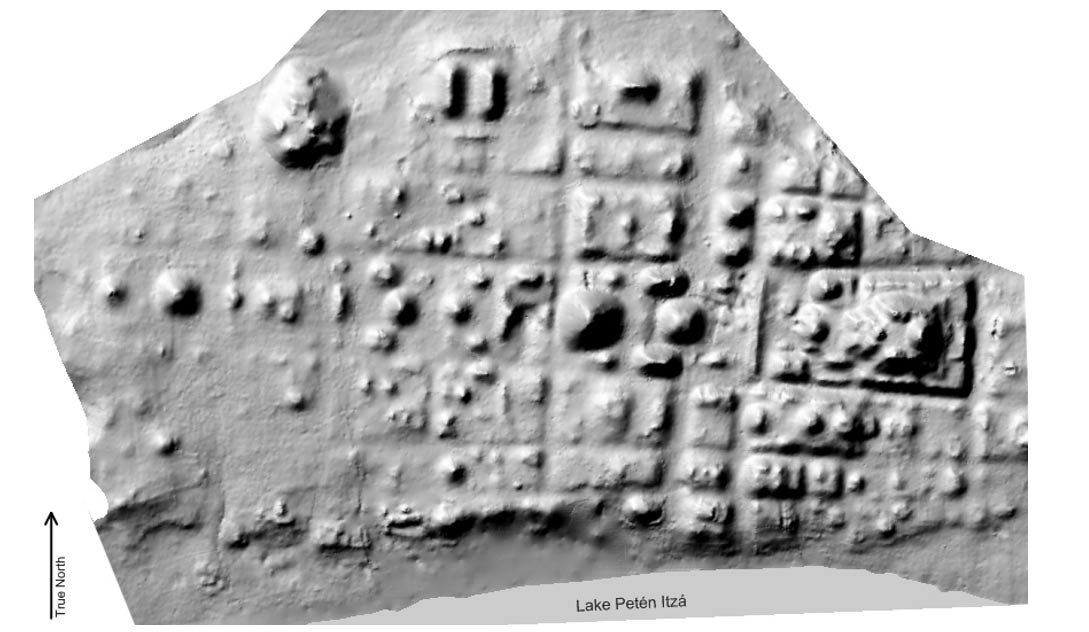2,600-Year-Old Maya City Found to Have Unique Grid Layout
A walled Maya city from 2,600 years ago was laid out in a grid that suggests the ruler who oversaw the design was a particularly powerful person. The city, Nixtun-Ch'ich' in Petén, Guatemala, is being protected from looters by the ranchers who own the land upon which the ancient city is situated.
The city has flat-top pyramids and other large structures that were oriented on an east-west axis that deviated by only 3 percent from true east, says an article in Live Science. It is the only Maya city designed in a grid. Another ancient Mexican city, Teotihuacan of the Aztecs, was laid out in a grid, but this was a different civilization.
"It's a top-down organization," archaeologist Timothy Pugh of Queens College of New York told Live Science. "Some sort of really, really, powerful ruler had to put this together."

Relief of a Maya prince; researchers speculate a powerful ruler oversaw the design of the city of Nixtun-Ch’ich’. (Photo by Wolfgang Sauber/Wikimedia Commons)
Pugh presented his team’s research to the Society for American Archaeology's Annual Meeting recently.
Live Science reported:
You get about 15 buildings in an exact straight line — that's the main ceremonial area,’ [Pugh] said. These 15 buildings included flat-topped pyramids that would have risen up to almost 100 feet (30 meters) high. Visitors would have climbed a series of steps to reach the temple structure at the top of each of these pyramids. At the end of the ceremonial way, on the eastern edge of the city, is a ‘triadic’ structure or group, which consists of pyramids and buildings that were constructed facing each other on a. Structures like this triadic group (the name comes from the three main pyramids or buildings in the group), have been found in other early Mayan cities. The residential areas of the city were built to the north and south of the ceremonial route and were also packed into the city's grid design, Pugh said.
By orienting the buildings from east to west, the designers may have been trying to help people follow the movements of the sun across the sky, something that was possibly important to their religion.
Some of the city’s buildings were covered in a lustrous white plaster, and researchers assume the city was a brilliant white. The building was encircled by a wall made of stones and earth, which indicated the people who lived there, from about 600 to 300 BC, were concerned about defense. This is the same period when cities were first being built in the region, in what is now Petén, Guatemala.
Pugh said Europeans who lived in grid cities were unhappy with the design. He speculated that perhaps people of Nixtun-Ch'ich’ may have been similarly displeased. Other Maya cities also had wide streets, but they were not organized in a grid.
People who live in the vicinity of the city now, have known about the ruins for years, Live Science says. Pugh said he is thankful the ranchers are protecting it. The ranchers also have been planting a type of grass that grows quickly and thereby decreases erosion of what remains of the city’s ancient buildings.
The city was probably isolated politically from other Maya cities and was an entity until itself, in keeping with the Maya norm. The Maya had a form of writing with glyphs, a calendar system, agriculture, sophisticated architecture, and the pantheon and religion that accompany every known civilization. Diseases brought to the New World by Spanish conquistadors had a devastating effect on the Maya, killing many. But there are millions of Maya people, their descendants, living today in Mexico and elsewhere.

Mayan hieroglyphs representing day signs (Wikimedia Commons)
There were hunter-gatherers in Central America for thousands of years before Maya civilization arose, but scientists are unsure what peoples of the world first inhabited the New World.
Pugh began has research at Nixtun-Ch’ich’ in 1995 and was focusing on Maya people’s remains from long after the city was abandoned. Meanwhile, he and his colleagues have been mapping and excavating the city.
Featured image: Aerial view of the city (Timothy Pugh photo)
By Mark Miller


















Comments
Amazingly interesting! The author of this article should consider revising it though: Although the ethnicity of the builders and dwellers of the city of Teotihuacan has still not been determined with certainty, it is certain that it pre-dates the Aztecs and was therefore NOT an Aztec city as stated in this article. Perhaps the author meant to write Tenochtitlan, the Aztec capital in the heydays of their civilization. I doubt it though, because as impressive as that city was, it was not constructed with the same grid-like pattern refered to in the article.
“The city has flat-top pyramids and other large structures that were oriented on an east-west axis that deviated by only 3 percent from true east”
Why? And also, why talk about deviations in orientation in percent rather than degrees, the normal way? What would 3% come to?
When archaeologists first excavated ancient Sumerian ruins, they found a deviation of about 1 degree in east west orientation. At first they assumed they didn’t know math, but now we know that the Sumerians and the Mayans had a tremendous grasp of math.
So why did both make a mistake? Or did the earth’s crust move some?
Under uniformitarian theories of geology, they got it wrong. But under catastrophe theory of astral catastrophes, which modern evidence supports big time, a shift in the crust could have occurred.
This year we will celebrate our first Asteroid Day, created to bring awareness to humans of the tremendous danger posed by thousands of large near earth orbit objects.
And since most evidence points to the last giant earth astral catastrophe occurring about 700 to 800 BCE, I suspect these ruins date back to about that date.
Tom Carberry